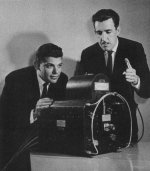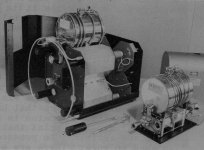Eidetical
Well-known member
- Joined
- May 14, 2022
- Messages
- 202
- Points
- 63
In 1962, a group of MIT scientists hit the moon with a pulsed ruby laser beam and detected its return (with a photomultiplier tube) for the first time. The Raytheon model LHM-1 they used is seen below. They used large telescopes on both outbound and inbound beams. Rangefinding to the moon was sooo important, they lugged that big heavy retroreflector array up on the first mission to land to get a much stronger signal.
I believe the human eye can detect a single photon of green light. I believe the few joules of output that Raytheon laser had can easily be topped by today's (probably 30 year old surplus) frequency doubled Nd:YAG lasers that can run faster than a few pulses per minute. I'd imagine that large telescope access is easier these days.
I wonder if it would be possible to actually see a green spot on the moon, looking through a big telescope. Yeah, I know, "Paint the Moon" garbage and all that from years ago, but I still gotta wonder. Keep that big scary laser spitting out those monster green q-switched pulses, modern tracking, adaptive optics, maybe multiple lasers hitting the same spot. I think I'd see me some green!
Anyway, here's the laser and the guys, and a pic of it without the cover next to the smaller model LH-3:


I believe the human eye can detect a single photon of green light. I believe the few joules of output that Raytheon laser had can easily be topped by today's (probably 30 year old surplus) frequency doubled Nd:YAG lasers that can run faster than a few pulses per minute. I'd imagine that large telescope access is easier these days.
I wonder if it would be possible to actually see a green spot on the moon, looking through a big telescope. Yeah, I know, "Paint the Moon" garbage and all that from years ago, but I still gotta wonder. Keep that big scary laser spitting out those monster green q-switched pulses, modern tracking, adaptive optics, maybe multiple lasers hitting the same spot. I think I'd see me some green!
Anyway, here's the laser and the guys, and a pic of it without the cover next to the smaller model LH-3:








